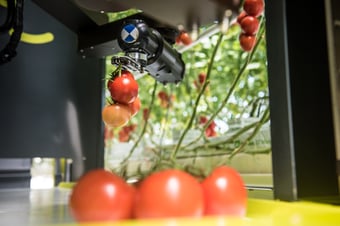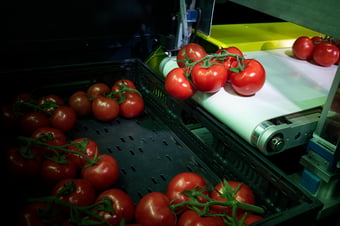As a global leader in horticulture technology, Ridder developed the GRoW harvest robot with the Israeli robotics start-up MetoMotion. Ridder and MetoMotion's shared desire to help growers with labor shortages and sustainable growing resulted in a joint effort to make robotics widely available to the greenhouse industry.
Get to know the GRoW robot with these top 20 key insights.
Key Insights on How GRoW Works with people
- The gap between labor demand and available workers has doubled over the past ten years, and industry analysts expect this trend to continue. As fewer people are entering the horticulture workforce, the need for robotic co-workers for labor-intensive tasks such as harvesting crops is growing.
- GRoW can be an efficient and essential part of the workforce. On a weekly basis, GRoW can harvest a production area equal to the harvesting output of 5 people.
- But that's not to say that GRoW completely replaces manual labor in the greenhouse. As a machine, it still requires supervision. Yet, it takes just one supervising operator to maintain up to 5 GRoW harvesting robots. This means that with the help of the GRoW robots, one supervising employee has an output equal to 25 human labors.
- Robotic harvesting with GRoW can reduce manual labor in a commercial tomato greenhouse by a baseline of 80%.
- GRoW's core function is harvesting tomatoes on the vine. But its additional functionalities, such as data collection, also reduce the amount of labor hours needed for IPM scouting and data collection for yield prediction.
Key Insights on GRoW’s Harvesting Process
- GRoW is able to pick a growing selection of commercial tomato varieties, which is constantly being updated, helping GRoW become ever more helpful in the greenhouse.
- GRoW is extremely accurate with its harvesting process. It uses ripeness, size, color, and fruit count as selection parameters for vine tomatoes.
- GRoW's ripeness detection has a 12-color grade selection between the spectrum of green and red tomatoes. This is far more accurate than the capabilities of the human eye and ensures a higher level of consistency across the harvest.
- GRoW can harvest multiple variations of truss tomato selections during the picking process based on the numbers of fruit per truss, ripeness, size, and color levels.
- Growers can choose to set exceptions in GRoW's selection criteria - for example, not to harvest a certain color of tomato ripeness, unless they are below a certain size. Or preset a minimum amount of average ripeness for the whole truss.
- GRoW's 3D mapping system calculates the positions of all obstacles, fruit, and organic material in the greenhouse space to approach and harvest the trusses in the most efficient and secure manner.
- Using a similar 3D mapping system, GRoW has an advanced obstacle detection process that identifies and solves complex situations presented in the environment. This means it will avoid collisions with any objects such as stems, twines, or persons.
- GRoW will not damage crops when picking. It is designed to precisely cut the TOV stems and will not cut the stem of the crop itself or cut the tomato twine.
- GRoW is a collaborative and safe co-worker; its advanced safety processes and sensors avoid accidents in the workplace for robots, plants, and workers.
- GRoW's working process is developed to not only pick but also pack. It picks the trusses and then boxes the tomatoes into a 40 x 60 cm container, making it ready to pack.
- GRoW's onboard boxing system is specifically designed for use with Reusable Packaging Containers (RPCs) – this enables common, easy integration into existing fresh produce transporting and packaging & handling systems.
Key Insights on GRoW’s Technologies
- GRoW's smart battery management technology, along with battery-equipped GRoW-Assist harvesting trolleys, allows the harvest to take place without interruption to shut down the robot for charging. This enables 8-, 16-, or 24-hour harvesting shifts.
- When growers purchase their harvest robot, it automatically receives service and performance updates. This means GRoW's picking accuracy, speed, and performance are constantly improving and supported by lifetime service upgrades.
- GRoW's operation is simple and straightforward. It can be operated from a dedicated and user-friendly smartphone app by the operator.
- GRoW's performance, statistical information, and scouting data are available through a cloud data service and dashboard. Data transmission is supported by both WiFi and cellular connections. This supports predictive maintenance and remote servicing to ensure GRoW is never out of action.
Robotics vs. Human Labour
For more information and statistics about the transformative power of GRoW harvest robot check out the GRoW factsheet on robotic vs. human labour in the greenhouse.




